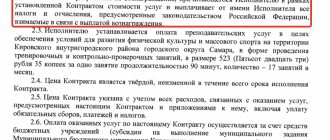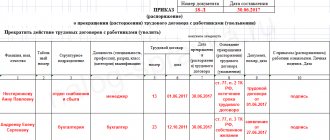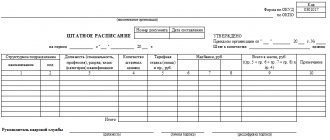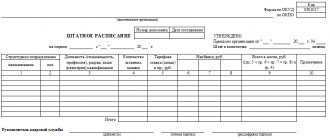Inventory schedule - sample
The legislation gives the management of the enterprise the right to independently determine the frequency of inventory checks. Their frequency reflects the inventory schedule and a separate item in the accounting policy. The exception is cases of mandatory unscheduled recalculation of values:
- during reorganization activities;
- when the liquidation of the organization has begun;
- when assessing the consequences of emergency situations;
- conducting an inventory is necessary to confirm the fact of theft or damage to property;
- preparation of annual reports;
- the inventory procedure must also be observed in the event of changes in the composition of financially responsible persons;
- inspection of property on the eve of their transfer to third parties for a fee or free of charge.
If there is a large volume of inventory items, it is advisable to draw up an inventory plan, a sample of which will help optimize the work of the members of the inventory commission. The inventory schedule includes mandatory information about:
- The list of objects subject to verification and recalculation,
- The composition of the inventory commission by name.
- Timing of audit actions indicating their frequency.
There is no sample inventory schedule approved by law. Its form is developed by the chief accountant. The document must contain the signature of the head of the institution approving the audit plan.
Atypical inventory errors as a reason for refusing to recover material damage from an employee
In accordance with Article 247 of the Labor Code of the Russian Federation, before making a decision on compensation for damage by specific employees, the employer is obliged to conduct an inspection to establish the amount of damage caused and the reasons for its occurrence. To conduct such a check, the employer has the right to create a commission with the participation of relevant specialists.
The main way to check the compliance of the actual availability of property by comparison with accounting data is recognized by virtue of the article of the Federal Law “On Accounting” to be an inventory of property, the procedure for which is defined in the Guidelines for the inventory of property and financial liabilities, approved by order of the Ministry of Finance of the Russian Federation dated June 13. 1995 No. 49 (hereinafter referred to as Guidelines).
What do employers most often stumble on when proving their claims in court to recover the amount of material damage from an employee? Based on examples of judicial practice, we can create a list of such errors:
- absence of receipts from those inspected materially responsible that by the beginning of the inventory all expenditure and receipt documents for the property were submitted to the accounting department or transferred to the commission, and all valuables received under their responsibility were capitalized (violation of clause 2.4 of the Methodological Instructions);
- carrying out an inventory in the absence of the inspected financially responsible person (violation of paragraph 2.8 of the Guidelines);
- incorrect correction of errors in inventories (violation of paragraph 2.9 of the Guidelines);
- absence of an order to appoint an inventory commission (violation of paragraph 2.3 of the Methodological Instructions);
- failure to complete inventory and matching lists (violation of clauses 2.5, 2.9, 4.1 of the Methodological Instructions);
- absence of signatures of all members of the inventory commission and financially responsible persons being inspected (violation of paragraph 2.10 of the Methodological Instructions);
- the absence at the end of the inventory of a receipt from the inspected financially responsible person confirming the inspection of the property by the commission in their presence, the absence of any claims against the members of the commission and the acceptance of the property listed in the inventory for safekeeping (violation of clause 2.10 of the Methodological Instructions);
- admission during the inventory period of unauthorized persons to the premises where it is being carried out (violation of paragraph 2.12 of the Methodological Instructions);
- and other errors.
The listed errors are perhaps the most common in the inventory procedure.
But in practice there are other, less popular mistakes, which are also worth paying attention to and taking them into account, so to speak, from the experience of others, without allowing them to be committed on your own. Let's look at some of them. Non-standard error: an inventory was not taken when hiring the financially responsible person
According to paragraph 1.5 of the Methodological Instructions, inventory taking is mandatory, including when changing financially responsible persons (on the day of acceptance and transfer of cases). The employer's mistake is that when hiring a new employee, who is entrusted with full financial responsibility, an inventory was not carried out. Such an error leads to the fact that when a shortage is subsequently established, the employer is unable to prove the period of the shortage (whether it formed before the hiring of a new employee or during his work), as well as the guilt of the new employee specifically in the shortage.
The employer filed a lawsuit against M. to recover the shortfall, indicating that the defendant was hired as a cashier-salesperson and an agreement on financial liability was concluded with her. During the defendant’s performance of his labor duties in the period from (...) to (...), a shortage arose in the amount of (...) rubles, which M. recognized, but did not pay, but quit.
When considering the dispute, the court gave a proper assessment of the documents presented by the plaintiff, including: notebooks recording the receipt and sale of goods and the proceeds received from the sale of goods; audit reports for the store, according to which a shortage of (...) rubles was identified for the period from (...) to (...), and came to the conclusion that the documents presented cannot be considered admissible evidence, since they do not confirm the transfer to the defendant of those entrusted to her material assets during her working life and the formation of shortages due to the latter’s fault.
The plaintiff did not provide the court with evidence of an inventory of the goods on the date of the defendant’s hiring, transfer (handing) of these goods to the defendant, transfer of goods from one seller to another during a shift at the workplace. Agreements on collective liability with the participation of M. were also not concluded. Taking into account also that the employer did not carry out a proper check in order to establish the size of the shortage, the reasons for its occurrence, despite the fact that the court established circumstances excluding the financial liability of the employee, including improper maintenance of financial and economic documentation by the employer, the court came to the correct conclusion conclusions about the refusal to satisfy the stated claim (decision of the Dzerzhinsky District Court of Orenburg dated January 29, 2014; appeal ruling of the Orenburg Regional Court dated April 21, 2014 in case No. 33-1925/2014).
Conclusion: in order not to subsequently experience difficulties in proving your claims to an employee for compensation for material damage, you should initially, that is, when hiring a new financially responsible person, strictly comply with the requirements of the legislation of the Russian Federation, in particular, carry out an inventory in accordance with the requirements of paragraph 27 “Regulations on accounting and financial reporting in the Russian Federation”, approved by order of the Ministry of Finance of the Russian Federation dated July 29, 1998 No. 34n, and paragraph 1.5 of the Methodological Instructions, as when changing materially responsible persons.
Note!
In paragraph 4 of the resolution of the Plenum of the Supreme Court of the Russian Federation dated November 16, 2006 No. 52 “On the application by courts of legislation regulating the financial liability of employees for damage caused to the employer” it is explained that the obligation to prove the presence of direct actual damage, the amount of damage caused when resolving a case for compensation for damage the employee is assigned to the employer.
Circumstances that are essential for the correct resolution of a case of compensation for damage by an employee, the obligation to prove which rests with the employer, in particular, include: the absence of circumstances excluding the financial liability of the employee; illegality of behavior (actions or inactions) of the harm-doer; the employee’s guilt in causing the damage; a causal relationship between the employee’s behavior and the resulting damage; the presence of direct actual damage; the amount of damage caused; compliance with the rules for concluding an agreement on full financial liability.
Failure to prove one of these circumstances excludes the employee’s financial liability.
If the employer proves the above circumstances, the employee must prove the absence of his guilt in causing the damage.
Non-standard error: the disputed fact of damage and the employee’s guilt cannot be confirmed by an incorrectly prepared report of an independent auditor
If the report of the audit commission is controversial, the fact of damage caused by the head of the enterprise can be confirmed by the report of the audit commission and the report of an independent auditor. To be recognized as relevant and admissible evidence, these documents must be properly executed. Otherwise, an incorrectly executed document cannot be used as the basis for proving the legality of the employer’s demands to recover the amount of material damage from the employee.
The HOA tried to recover material damages from the former chairman of the board. As evidence of its claims, the HOA presented a report from an independent auditor, which concluded that the former chairman had spent money from the HOA account unjustifiably. The court did not take into account the report, since this act is not reliable and sufficient evidence of damage caused by the defendant as a result of failure to perform or improper performance of official duties (unreasonable expenditure of funds received by the employee for business needs). In support of its conclusions, the court stated the following.
The court analyzed the provisions of the HOA charter, according to which the audit commission (auditor) conducts scheduled audits of the financial and economic activities of the partnership at least once a year; presents to the general meeting a conclusion on the estimate of income and expenses for the corresponding year of the partnership and a report on financial activities and the amount of mandatory payments and contributions; reports to the general meeting on its activities. Based on subsequent provisions of the charter, the activities of the audit commission may be insufficient for the normal functioning of the partnership, and therefore, by decision of the governing bodies of the HOA (general meeting, board meeting), a professional auditor may be invited to audit the financial and economic activities of the partnership. At the same time, the report submitted by the plaintiff was compiled by a certain L.A. without indicating the position held and the institution in which she carries out her labor (civil) activities. The report has no corner stamp or seal. On the back there is a note that this document is stitched and numbered 12/02/2013 L.O., that is, almost seven months from the date of the report.
At the same time, a report from the HOA audit commission was presented to the court, which, before contacting the auditor, conducted an audit of the expenditure of funds by the chairman of the board for the disputed period. Based on the results of this audit, no violations of financial discipline were found, and no misappropriation of funds by the employee was detected. Under such circumstances, the court had reason to consider the auditor’s report as unacceptable and insufficient evidence that does not indisputably and reliably confirm the fact that the defendant caused damage in the amount declared by the plaintiff, as well as the amount of damage itself (decision of the Pervomaisky District Court of Omsk dated January 29, 2014; appeal ruling Omsk Regional Court dated 05/07/2014 in case No. 33-2787/2014).
Conclusion: the report of the audit commission of the enterprise to resolve the issue of recovery of material damage from the head of the enterprise will have priority over an improperly prepared report of an independent auditor.
In both examples given from practice, the employer collected a weighty evidence base of the fact of damage, its size, the guilt of a particular employee, and evidence of a cause-and-effect relationship between the employee’s misconduct and the resulting material damage... It would seem, based on the examples given, that it would have been possible to assume It is impossible that, despite the employer’s preparedness for a positive court decision, the plaintiff employer will be refused to recover damages from his employees. Alas, practice has shown that this is real.
In the opposite situation, when the chances of a positive decision are low, the employer manages to win the dispute. As a rule, we are talking about situations where the financially responsible person being inspected shows all possible resistance to conducting an inventory, refuses to sign anything and is pre-determined to challenge every step of the employer in the procedure for bringing him, as an employee, to full financial responsibility.
The most important thing is to properly document each step in the procedure for holding an employee financially liable.
Even if an employee refuses to sign a particular document, this is not a reason for further invalidating the inventory results. But the absence of a corresponding act drawn up by the employer’s employees on recording the fact of such a refusal is, of course, a reason for recognizing the requirements of regulations (usually Methodological Instructions) for the procedure for conducting an inventory as unfulfilled, and the results of the inventory as invalid. In connection with the above, there is no need to fear “resistance” from the financially responsible person. You just need to carefully and scrupulously fill out all the documentation related to proving the fact and amount of material damage and holding the employee financially liable.
The employer, an individual entrepreneur, filed a lawsuit against G. for the recovery of the amount of material damage, indicating that G. was in an employment relationship with the individual entrepreneur in the position of curator of a retail chain, and performed labor duties in a store. According to invoice No. 14, she received a laptop for transfer to the store for the purpose of further use in work; according to the results of the inventory, the absence of the specified laptop in the store was revealed. Defendant G. did not provide any explanations, refused to sign the inventory list and comparison sheet, resigned of her own free will, did not return the laptop upon dismissal, which caused damage to the plaintiff. The employer presented to the court evidence of the transfer to the employee of material assets (in the form of a laptop) using a one-time document, and the results of the inventory. The court came to the conclusion that the procedure for conducting an inventory of the organization’s property and recording its results, regulated by the Methodological Guidelines, was observed by the individual entrepreneur. As follows from the acts, G. refused to familiarize herself with the inventory list of inventory items (compiled based on the results of the inventory), and refused to familiarize herself with the collation sheet of the inventory results. Based on the evidence presented, the court reasonably came to the conclusion that there were grounds to recover from G. in favor of the individual entrepreneur the amount of damage caused (decision of the Krasnokamsk city of the Perm Territory dated January 29, 2014; determination of the Perm Regional Court dated April 23, 2014 in case No. 33-3515).
Conclusion: if the inventory of valuables is carried out correctly, and the refusal of the materially responsible employee to sign somewhere is documented, the court considers the procedure for conducting an inspection to establish the amount of damage caused and the reasons for its occurrence, established by Article 247 of the Labor Code of the Russian Federation, to be complied with.
Summarizing the analyzed case studies, the following conclusions can be drawn:
- knowing the requirements of the Methodological Recommendations for the correct registration of inventory results is not enough;
- To avoid standard errors when recording inventory stages and bringing an employee to financial responsibility, it is sufficient to study the norms of the Labor Code of the Russian Federation in conjunction with special literature, methodological materials, as well as generalizations of judicial practice and explanations of the resolution of the Plenum of the Supreme Court of the Russian Federation dated November 16, 2006 No. 52 “On the application courts of legislation regulating the financial liability of employees for damage caused to the employer";
- To eliminate rare but fatal errors when proving the fact of material damage and the employee’s guilt, a careful study of examples from wide judicial practice will be required. Of course, this will take time and persistence. However, the result will be a positive court decision for the employer, and not an unexpected and therefore offensive refusal to satisfy the employer’s completely legitimate, but unproven demands.
Hello Guest! Offer from "Clerk"
Online professional retraining “Accountant on the simplified tax system” with a diploma for 250 academic hours . Learn everything new to avoid mistakes. Online training for 2 months, the stream starts on March 15.
Sign up
General rules for conducting inventory
Clause 2 of the Methodological Instructions of Order No. 49 of the Ministry of Finance reveals the rules for conducting inventory. They apply to:
- the responsibility of enterprise management to determine the frequency of inspections;
- aspects of the formation of the commission;
- inventory regulations;
- documentation of the audit results.
The procedure for conducting an inventory involves issuing an order to form a commission. It should include representatives of:
- administrative department;
- accounting employees;
- employees attracted from other departments.
Inventory rules prohibit inspections in the absence of even one of the commission members. It is also mandatory that all involved persons familiarize themselves with the data from reports on the movement of material assets and monetary resources, as well as receipt and expenditure documentation.
How to conduct an inventory - with or without the participation of financially responsible persons? The presence of this category of employees is mandatory. Before the start of audit activities, they give a receipt for the completion of operations to document the movement of property. The procedure for carrying out an inventory at an enterprise involves a piecewise count of all valuables; if necessary, they must be weighed and measured.
If the audit extends over several days, the premises with the assets being inspected are sealed. The inventory schedule, a sample of which you will find below, should allow sufficient time for summing up the results of the inspection and documenting them. The results of the audit are entered into the inventory manually or using office equipment. The document form is signed by all participants in the verification process - members of the commission and financially responsible persons.
Form
Unlike the order to carry out an inventory, which can be drawn up on a unified form No. INV-22, an order on the results of an inventory is formed in any form without any restrictions or requirements from the legislative norms of the Russian Federation. Such an order can be drawn up on a simple sheet of A4 paper or on the company’s letterhead.
This order must contain the following information:
- Business name.
- The name of the document, assigning a number to it, and a brief display of the topic and the structural department where the inventory is carried out.
- Place and date of its compilation.
- Preamble, indicating the basis for issuing the order.
- The administrative part of the document, where the director announces the necessary measures based on the results of the inspection, and also appoints the person responsible for the implementation of the order.
- Director's signature.
- Signatures of officials noted in the order.
How is inventory taken and why is it needed?
Inventory of goods and materials at a company is an important event in its activities. The implementation of such a procedure is regulated by internal departmental local acts developed by the company taking into account the requirements of the legislation of the Russian Federation.
Thanks to periodic inventory, it is possible to track the availability of property, its quantity and condition, ensuring reconciliation of the count with accounting data, which makes it possible to assess the financial condition of the enterprise.
The obsolete, worn-out or damaged property identified during such an inspection, according to the conclusion of the inventory commission, is sent for repair or subject to write-off.
What is needed for the procedure?
To carry out an inventory of a company, the director must issue an order to create an inventory commission. Its members are required to have the authority to verify the compliance of existing inventory and materials with the data displayed in accounting. The commission must consist of at least 3 people.
To organize an inventory, the accounting department must transfer to the commission the accounting data for inventory items of the department where the audit is planned to be carried out.
If necessary, the inventory location can be sealed. The task of the commission is to ensure that the actual availability of inventory items corresponds to the accounting data in the accounting documents.
To legally carry out this procedure, you will need the following documents:
- An order to begin the inventory, signed by the director.
- Reports of officials responsible for the safety of inventory items.
- A document containing comparative test results with accounting data.
- The final act of the results of the availability of property, signed by all members of the commission.
( Video : “How to draw up an order for an inventory?”)
Who conducts it?
The inventory is carried out by a commission created by order of the director of the enterprise. Such a commission may include specialists, including the chief accountant, the head of the structural department, whose property is subject to inspection, as well as employees of other departments, for example, a lawyer, chief. engineer, etc. At the same time, financially responsible persons cannot be included in the commission, however, they are required to be present during the inventory of goods and materials, for the safety of which they are responsible.
The purpose of the commission is:
- Checking the presence/absence of inventory items.
- Reconciliation of its quantity with accounting records.
- Preparation of final reports showing the results of the audit.
What to rely on when forming an order?
The basis for publishing an order on the results of the inventory is the submitted final act based on the results of the inspection of inventory items. The final inventory report, as a rule, displays the commission’s proposals for taking certain measures to eliminate the identified comments. Therefore, such an order should be based on the legislative norms of the Russian Federation, as well as on internal departmental regulations developed at the enterprise (acts, memos, accounting policies, etc.).
Inventory notification
The mechanism for notifying all interested parties about the upcoming inventory involves familiarizing them with the following documents:
- inventory schedule;
- order to carry out audit activities.
An additional, but optional measure is the official delivery of a written notice to the materially responsible employee. The procedure for conducting an inventory involves handing over this document to the employee personally against signature or by sending it by mail. To confirm the fact that interested parties have been notified of the upcoming inspection, the employer can use the received receipt or receipt of the postal item being accepted by the communications center operator.
INVENTORY: TIMELINE, GOALS, REGULATORY FRAMEWORK
Inventory is a way of checking the actual availability of property by comparing the information received with data from accounting registers.
The cases, timing, procedure for conducting an inventory and the list of objects subject to inventory are determined by the economic entity, with the exception of the mandatory inventory.
Carrying out an inventory is mandatory:
• when transferring property for rent, redemption, sale, transformation of a state or municipal unitary enterprise;
• before drawing up annual financial statements (except for property, the inventory of which was carried out no earlier than October 1 of the reporting year);
• when changing financially responsible persons;
• when facts of theft, abuse or damage to property are revealed;
• in case of a natural disaster, fire or other emergency situations caused by extreme conditions;
• upon liquidation (reorganization) of the organization;
• in other cases provided for by the legislation of the Russian Federation.
Regulatory legal acts regulating the inventory:
• Order of the Ministry of Finance of Russia dated June 13, 1995 No. 49 (as amended on November 8, 2010) “On approval of the Methodological Guidelines for the Inventory of Property and Financial Liabilities”;
• Federal Law No. 402-FZ dated December 6, 2011 (as amended on July 26, 2019) “On Accounting”;
• Order of the Ministry of Finance of Russia dated July 29, 1998 No. 34n (as amended on April 11, 2018) “On approval of the Regulations on accounting and financial reporting in the Russian Federation”
In accordance with the specified documents, all property of the organization is subject to inventory, regardless of its location. The organization's property includes:
- fixed assets ( OS );
- intangible assets ( intangible );
- financial investments;
- industrial stocks, finished products, goods, other stocks;
- cash and other financial assets.
The following are also subject to inventory:
• inventories and other types of property that do not belong to the organization, but are listed in its accounting records (those in safekeeping, leased, received for processing);
• property not taken into account for any reason.
Main objectives of inventory:
• identify the actual availability of property;
• compare the actual availability of property with accounting data;
• check the completeness of recording of liabilities.
Stages of inventory
The inventory stages can be divided into several blocks:
- preparatory activities;
- counting, measuring and weighing property;
- comparison of actual data with reported data;
- documentary recording of the audit results.
Step-by-step instructions for conducting an inventory:
- Formation of an inventory commission.
- Familiarization with accounting information on the quantitative composition of property.
- Drawing up a receipt by the financially responsible person.
- The inventory begins - the assets of the enterprise are recalculated in physical terms. It is important to check the technical serviceability of each object. It is possible to implement reconciliation with counterparties.
- The next stages of conducting an inventory involve entering the information received about actual availability into inventory records. Next, the fact is compared with the data contained in the reporting documentation.
- The inventory stages must be carried out in strict accordance with the sequence. The final step will be to identify discrepancies and record them in the minutes of the commission meeting and the final act, adjusting accounting data (if necessary).







